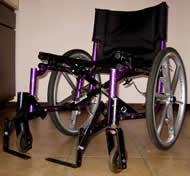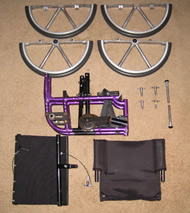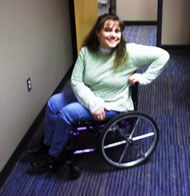Faculty Advisors: Mehdi Pourazady, Ph.D., and Mohamed Samir Hefzy, Ph.D., PE, ASME Fellow
Biomechanics and Assistive Technology Laboratory,
Dept. of Mechanical, Industrial and Manufacturing Eng., The University of Toledo, Toledo, Ohio 43606
ABSTRACT
The purpose of this project was to develop a collapsible wheelchair, with detachable wheels, backrest and seat. When detached and collapsed, all components of the wheelchair fit in a carry-on luggage whose dimensions are 22” x 14” x 9”. The developed unit was constructed using a standard folding manual wheelchair frame that was modified to make the backrest and seat detachable from the frame. The unit includes two 20 inch wheels; each one is detached into two semi circular parts. The foot rest and the two front caster assemblies were modified to allow them to fold up into the wheelchair frame. The unit is assembled and disassembled with minimal time and effort. Figure 1 shows the prototype assembled, and figure 2 shows all its components when detached.
KEYWORDS:
Detachable; Collapsible; Manual Wheelchair; Carry-on Luggage
BACKGROUND/STATEMENT OF THE PROBLEM
Wheelchairs users must take their wheelchairs with them when they travel. Airlines have limited or no space available for storing standard folding wheelchairs in the cabin of the airplane. The closet in which the wheelchairs are stored is filled on a first come first serve basis (1). If the closet is filled or no closet space is available the wheelchair is then considered as checked luggage. It then becomes unprotected from items falling on it, being thrown or dropped, or any type of damage that may arise from carelessness of airline employees. If extensive damage to the wheelchair occurs it may become inoperable. The wheelchair can also become lost luggage and not arrive at the correct final destination. A lost or inoperable wheelchair is an extreme inconvenience to the wheelchair user.
There are a few existing wheelchair designs on the market that are considered to be collapsible. These designs collapse smaller than standard folding wheelchairs but are not small enough to fit in a carry-on luggage. Some of the designs are heavy and bulky (2) and none of the existing designs feature collapsing wheels. Other collapsible designs collapse to a small dimension but require someone to push the wheelchair from behind because the wheelchair utilizes four very small caster wheels, which does not allow the user to independently propel it (3). This requires the wheelchair user to depend on someone else to assist in their mobility. The purpose of this project was to design a wheelchair whose components collapse and detach to fit in a carry-on luggage with maximum dimensions of 22” x 14” x 9” deep (4).
METHODOLOGY/DESIGN
Design requirements included 1) the wheelchair must fit with a 22” x 14” x 9” suitcase; 2) the wheelchair must be durable; 3) the wheelchair must be assembled and disassembled easily and quickly, and 4) the wheelchair must allow independence in mobility when assembled.
Early in the project it was realized that that the greatest challenge to overcome was to design the largest diameter wheel to fit into the desired dimensions since a carry-on luggage allows a maximum solid wheel diameter of 14 inches; which is 10 inches smaller than a standard 24 inch diameter wheel. Several different wheel designs were considered and a detachable wheel was designed. The wheel is a two piece system which allows the maximum outer diameter of the assembled wheel to be twenty inches. Figure 2 shows the two parts of this detachable wheel. When detached, each of the two halves of the wheel has a dimension of twenty inches long by ten inches wide allowing them to fit in a carry-on suitcase. One half of the wheel contains two locating pins positioned on the top and bottom of the center support spoke. The second half contains two tabs with locating holes, in which the locating pins of the first half of the wheel rest when assembled. The locating pins ensure alignment in the plane of the wheel. Once the locating pins have been set, the two halves are connected together by two 3/8” diameter ball detent pins which align the two halves in the off-plane direction and help hold them together. The solid rubber tire is attached to the outer rim with screws and is cut in the location where the rim separates into two halves. The wheel bearings are pressed into the hub of the wheel half that contains the locating pines, which ensures the bearings will not be lost or damaged. The wheel is made of 4340 chrome-moly steel.
Several frame design ideas were also considered and it was decided to modify a donated wheelchair frame for this project. In order to make the collapsed frame fit within the desired dimensions, the back rest and seat sections of the frame needed to be removed and the front casters needed to fold into the frame. The front casters were modified to swivel upwards towards the chair for storage. Replacing the lower caster mounting bolt with a quick disconnect pin allows the caster to swivel up and into the frame for storage yet remain locked in place when assembled. The seat support bars and the back rest support bars were modified to become removable as well. Quick disconnect pins were used for this purpose.
RESULTS/EVALUATION
Solid Works 2009 finite element analysis software was used to conduct a structural analysis on the wheelchair wheels and a factor of safety greater than 3 was calculated with a one hundred pound load applied at the center hub of each assembled wheel. When collapsed the wheelchair was stored in a 22” x 14” x 9” suitcase and weighed about 33 pounds. Although the wheel diameter of 20” was smaller than a standard wheelchair wheel (24”), the wheelchair remained easy for its user to independently propel.
The developed prototype was evaluated by a wheelchair user as shown in figure 3. The Quebec User Evaluation of Satisfaction with assistive Technology (QUEST 2.0) tool was used as an outcome measurement instrument to measure satisfaction with the unit (5). The eight QUEST items that were assessed include comfort, dimensions, simplicity of use, effectiveness, durability, ease in adjusting, safety and weight. Each item was scored with a 5-point satisfaction scale ranging from a score of 1 denoting “not satisfied at all” to a 5 indicating “very satisfied”. A score of 4 was attained for simplicity of use, ease of adjusting and weight, and a score of 5 was attained for each of the other 5 items.
CONCLUSION
A collapsible wheelchair with detachable components was developed to allow a wheelchair user to store it in the overhead carry-on luggage compartment when traveling by air. This design saves space, prevents damage to the wheelchair by the airlines, and enables wheelchair users to travel with greater ease. The developed unit can be disassembled and reassembled quickly and easily yet it is still durable and reliable enough for everyday use while traveling. The developed unit thus provides wheelchair users with greater independence as they can independently disassemble the unit, store it in a carry-on luggage compartment, and reassemble it when they arrive at their destination. Also, the small collapsed size of the wheelchair makes storing it in a vehicle easier.
REFERENCES
- United Spinal Association (2009). Accessible Air Travel. Retrieved from http://www.unitedspinal.org/pdf/accessible_air_travel.pdf
- Roche, J.. Mobility Vision. Activator. Retrieved from http://www.mobility-vision.com/activator.html
- 1800WHEELCHAIR.com Inc. (2010) Travel Wheelchairs. Retrieved from http://www.1800wheelchair.com/asp/view-categoryproducts.asp?category_id=499
- Rowell, D. M. (25 June 2004). Airline Carry On Luggage Allowances. Retrieved from http://thetravelinsider.info/travelaccessories/airlinecarryonluggageallowances.htm
- Demers, L., Weiss-Lambrou, R., & Ska, B. (2002) The Quebec User Evaluation of Satisfaction with Assistive Technology (QUEST 2.0): An Overview and Recent Progresses. Technology and Disability, 14, pp. 101-105.
ACKNOWLEDGEMENTS
This work was supported by grant BCS-0931643 from the Research to Aid Persons with Disabilities Program from the Biomedical Eng. and Eng. Healthcare cluster of the CBET Division of the NSF.
AUTHOR CONTACT INFORMATION [Corresponding Author]
c/o Mohamed Samir Hefzy
Biomechanics and Assistive Technology Laboratory
Department of Mechanical, Industrial and Manufacturing Engineering
The University of Toledo, Toledo, Ohio 43606
E-mail: mhefzy@eng.utoledo.edu


